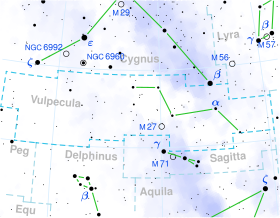| Observation data Epoch J2000 Equinox J2000 | |
|---|---|
| Constellation | Vulpecula |
| Right ascension | 20h 44m 52.50423s[1] |
| Declination | 25° 16′ 14.2538″[1] |
| Apparent magnitude (V) | 4.91[2] |
| Characteristics | |
| Spectral type | K1 III[3] |
| U−B color index | +1.18[2] |
| B−V color index | +1.19[2] |
| Astrometry | |
| Radial velocity (Rv) | +30.00[4] km/s |
| Proper motion (μ) | RA: −30.988[1] mas/yr Dec.: −184.648[1] mas/yr |
| Parallax (π) | 9.3255 ± 0.1537 mas[1] |
| Distance | 350 ± 6 ly (107 ± 2 pc) |
| Absolute magnitude (MV) | −0.07[5] |
| Orbit[6] | |
| Period (P) | 2,506±4 d |
| Eccentricity (e) | 0.383±0.023 |
| Periastron epoch (T) | 42511±29 MJD |
| Argument of periastron (ω) (secondary) | 272±5° |
| Semi-amplitude (K1) (primary) | 4.69±0.13 km/s |
| Details | |
| Mass | 1.55[7] M☉ |
| Radius | 21.68+0.47 −0.63[1] R☉ |
| Luminosity | 173.3±3.3[1] L☉ |
| Surface gravity (log g) | 2.47[8] cgs |
| Temperature | 4,498+67 −48[1] K |
| Metallicity [Fe/H] | −0.10[5] dex |
| Rotational velocity (v sin i) | 1.5[9] km/s |
| Age | 4.20[7] Gyr |
| Other designations | |
| Database references | |
| SIMBAD | data |
30 Vulpeculae is a binary star system in the northern constellation of Vulpecula, located mid-way between Epsilon Cygni and a diamond-shaped asterism in Delphinus. It is visible to the naked eye as a faint, orange-hued point of light with an apparent visual magnitude of 4.91.[2] The system is located approximately 350 light years away from the Sun based on parallax,[1] and is drifting further away with a mean radial velocity of +30 km/s.[4] The system has a relatively high proper motion, traversing the celestial sphere at the rate of 0.186 arc seconds per annum.[11]
The variable radial velocity of this system was announced in 1922 by W. W. Campbell. It is a single-lined spectroscopic binary system with an orbital period of 6.86 years and an eccentricity of 0.38. The a sin i value is 149 ± 4 Gm (1.00 ± 0.03 AU), where a is the semimajor axis and i is the orbital inclination. This provides a lower bound on the true semimajor axis.[6]
The visible component is an aging giant star with a stellar classification of K1 III[3] and an estimated age of 4.20[7] billion years old. Having exhausted the supply of hydrogen at its core, the star has expanded to 22[1] times the Sun's radius. It has 1.55[7] times the mass of the Sun and is radiating 173[1] times the Sun's luminosity from its swollen photosphere at an effective temperature of 4,498 K.[1]
- ^ a b c d e f g h i j k l Cite error: The named reference
GaiaDR2was invoked but never defined (see the help page). - ^ a b c d Cite error: The named reference
Ducati2002was invoked but never defined (see the help page). - ^ a b Cite error: The named reference
keenan1989was invoked but never defined (see the help page). - ^ a b Cite error: The named reference
Famaey2005was invoked but never defined (see the help page). - ^ a b Cite error: The named reference
XHIPwas invoked but never defined (see the help page). - ^ a b Cite error: The named reference
Griffin1983was invoked but never defined (see the help page). - ^ a b c d Cite error: The named reference
Luck2015was invoked but never defined (see the help page). - ^ Cite error: The named reference
McWilliam1990was invoked but never defined (see the help page). - ^ Cite error: The named reference
DeMedeiros2002was invoked but never defined (see the help page). - ^ Cite error: The named reference
SIMBADwas invoked but never defined (see the help page). - ^ Cite error: The named reference
Lepine2005was invoked but never defined (see the help page).
